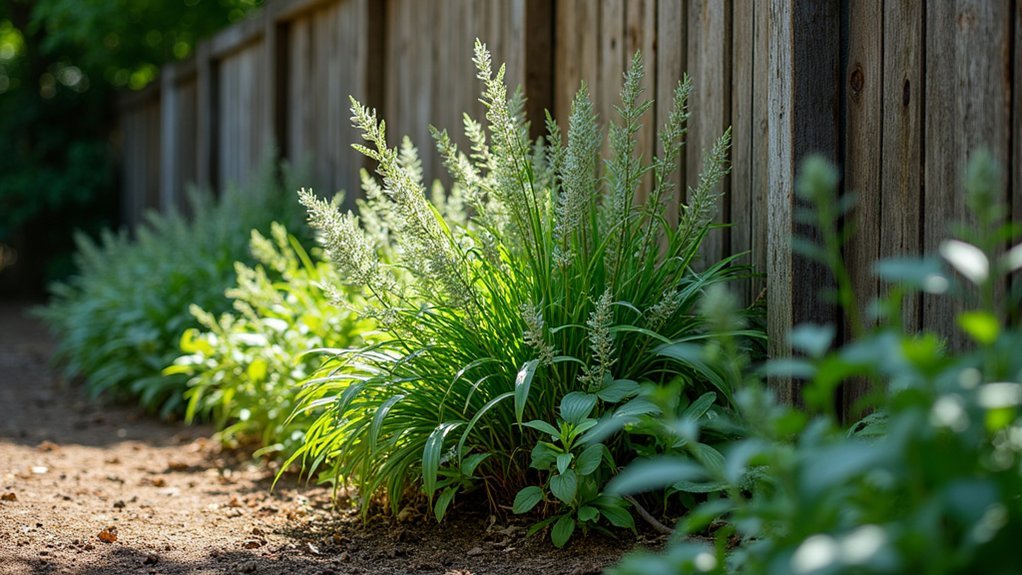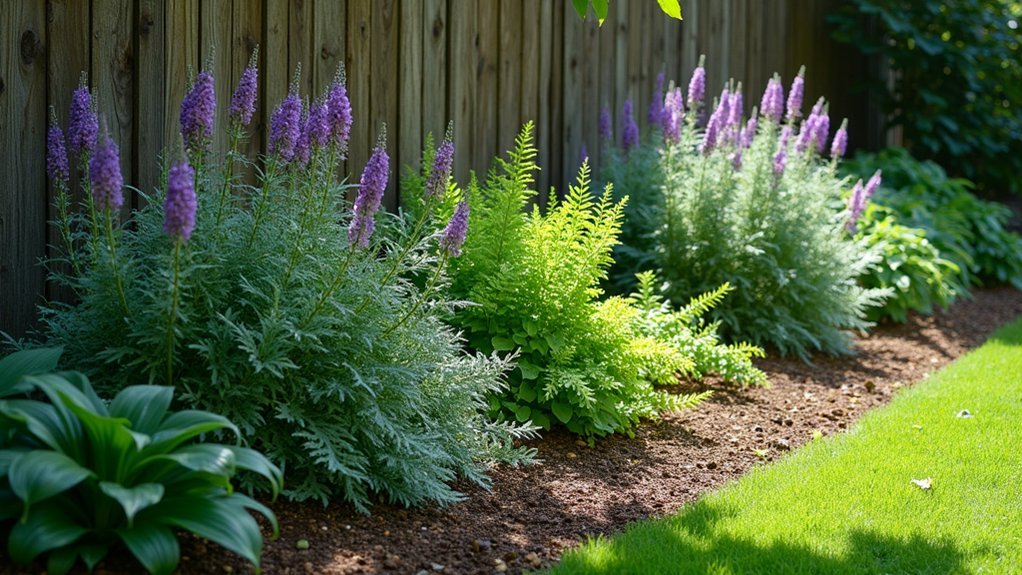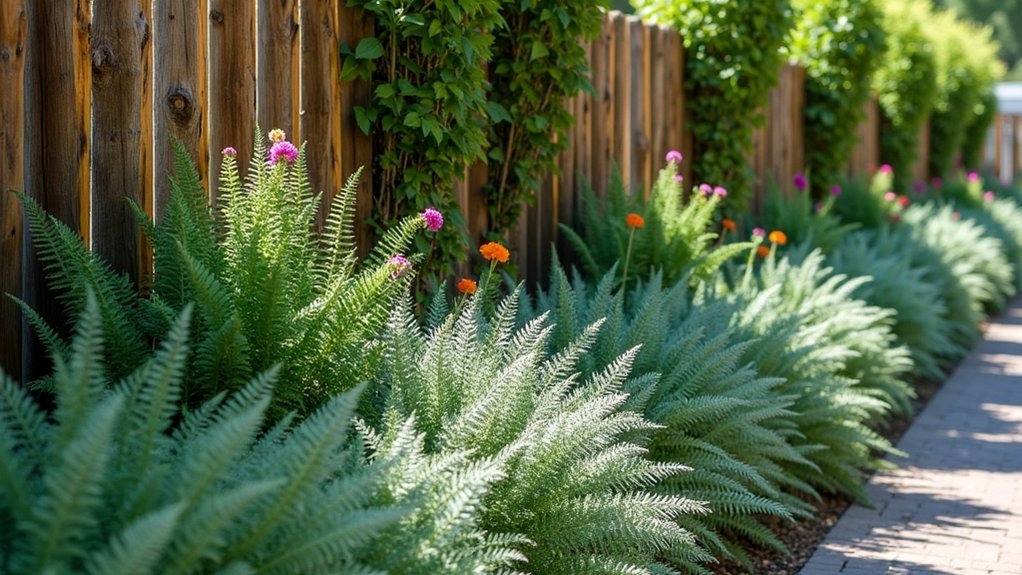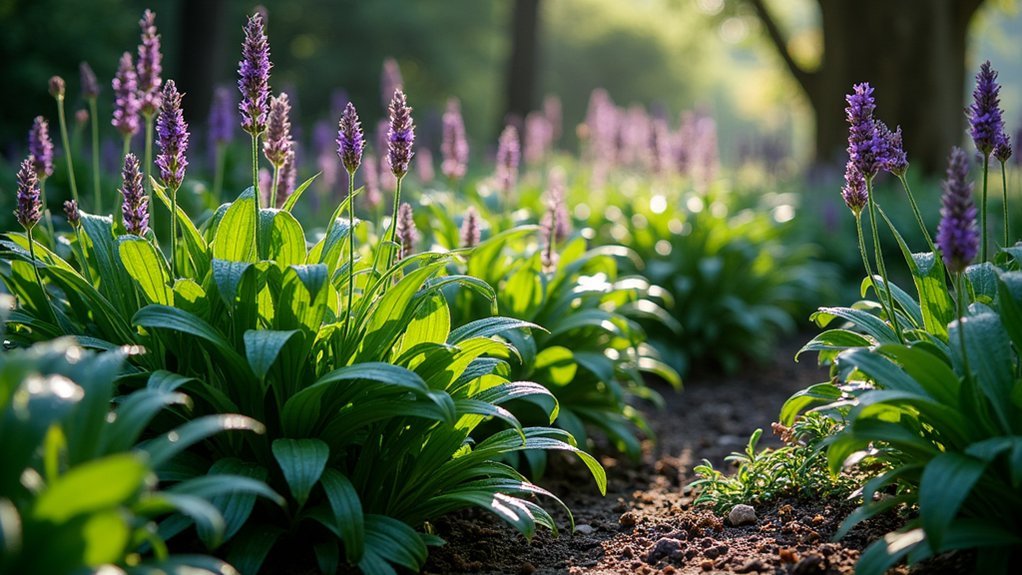For shady fence lines, choose drought-resistant plants like Boxwood ‘Sprinter’, Fragrant Sweet Box, or Creeping Oregon Grape for evergreen structure. Add perennials such as Bleeding Heart, Coral Bells, or Japanese Painted Fern for seasonal interest. Ground-covering Wild Ginger and Foamflower suppress weeds while requiring minimal water. Layer your selections with taller plants at the back and spreading varieties in front for a low-maintenance boundary that stays attractive year-round. Discover how these resilient options transform challenging spaces.
Understanding Dry Shade Challenges in Fence Lines

When it comes to landscaping challenges, few areas present as many difficulties as the shady zones along fence lines. Your traditional landscape plants struggle here because of the unique combination of problems: competition for moisture from tree roots and limited sunlight reaching the ground.
The soil along fence lines is often poorly drained, requiring careful plant selection to find species that handle both dry conditions and occasional moisture retention. Many shade-loving plants aren’t naturally drought tolerant, making your task even harder.
Native species often offer the best solution, as they’ve evolved to handle local conditions. During establishment, drought tolerant plants may need supplemental water, but once settled, they’ll thrive where others fail.
Look to your local ecosystem for answers—native plants may need initial care, but will ultimately conquer your fence line’s challenges.
Understanding these challenges is your first step toward creating a beautiful, resilient fence line garden.
Top Evergreen Shrubs for Water-Efficient Boundaries
Creating a beautiful, low-maintenance boundary doesn’t have to mean sacrificing aesthetics for practicality. These evergreen shrubs thrive in challenging shade conditions while requiring minimal water:
- Boxwood ‘Sprinter’ offers exceptional shade tolerance and disease resistance, making it perfect for water-efficient boundaries where reliability matters.
- Fragrant Sweet Box brings glossy leaves and sweet-scented winter blooms to deep shade areas, providing year-round coverage without demanding extra irrigation.
- Creeping Oregon Grape delivers bright yellow spring flowers and adapts to varying light conditions, creating lush ground coverage in dry, shaded fence lines.
- Diervilla ‘Kodiak’ Orange combines drought tolerance with stunning fall color, offering a deciduous option that thrives in dry shade while remaining deer-resistant for truly low-maintenance boundaries.
Hardy Perennials That Thrive Along Shaded Fences

While evergreen shrubs provide the structural backbone for shaded boundaries, hardy perennials offer seasonal interest and textural diversity along fence lines.
Layer your garden with purpose — evergreens establish structure while perennials bring life and texture to those challenging shaded boundaries.
For drama in spring, plant Bleeding Heart with its distinctive heart-shaped blooms reaching up to 3 feet before going dormant in summer. Coral Bells deliver year-round appeal with their colorful foliage and delicate pink flowers, performing admirably even in dry shade conditions.
For ground-level coverage, Wild Ginger creates a weed-suppressing mat under 12 inches tall, while Foamflower quickly spreads with frothy blooms in spring.
Add textural contrast with Japanese Painted Fern, whose silver-burgundy fronds stand out dramatically against wooden fences. These low maintenance perennials (all hardy in Zones 3-9) transform shaded fence lines from problem areas into garden highlights.
Ornamental Grasses and Groundcovers for Fence-Line Coverage
Several ornamental grasses and groundcovers offer elegant solutions for challenging shaded fence lines while demanding minimal water once established.
Japanese Forest Grass creates a stunning cascading effect that softens rigid fence structures while thriving in shade conditions.
For extensive coverage that suppresses weeds and adds visual interest, consider these drought-tolerant options:
- Wild Ginger – This native ground cover spreads beautifully in shade and requires little maintenance once established.
- Creeping Oregon Grape – Offers vibrant foliage and can handle dry shade conditions admirably.
- Japanese Painted Fern – Provides silvery-green accents that brighten shadowy areas.
- Cushion Spurge – Delivers unique texture and drought resistance along fence perimeters.
These low-maintenance options not only solve landscaping challenges but also promote biodiversity by creating valuable habitat for beneficial wildlife along your fence lines.
Designing a Layered Fence Planting for Year-Round Interest

A thoughtfully layered fence planting transforms dull boundaries into dynamic living tapestries that deliver visual interest across all seasons.
Create depth by positioning taller specimens like Bleeding Heart or Autumn Fern at the back, while allowing Wild Ginger or Foamflower to form a lush ground cover in front.
Layer your shade garden strategically, with taller plants providing backdrop and low-growing varieties creating lush foundation layers.
For your shade garden, combine drought-resistant plants with varied textures and colors—Coral Bells, Hellebore, and Japanese Painted Fern work beautifully in part to full shade conditions.
You’ll guarantee year-round interest by selecting plants with staggered blooming periods: Hellebore’s winter flowers complement Coral Bells’ summer blooms.
Include evergreen options like Boxwood to maintain structure during dormant months.
To minimize maintenance, group plants with similar water requirements that thrive together in well-drained soil, creating a cohesive visual display that evolves through the seasons.
Frequently Asked Questions
What Plant Is Shade and Drought Tolerant?
You’ll find Japanese Painted Fern, Coral Bells, Wild Ginger, Lungwort, and Hardy Ferns are all excellent shade and drought tolerant plants. They’ll thrive in those challenging conditions while adding beautiful foliage to your garden.
What Will Grow in 100% Shade?
You’ll find several options for 100% shade areas. Ferns like Japanese Painted and Autumn varieties, Hostas, Lungwort, Bleeding Heart, and Wild Ginger all thrive without direct sunlight in their appropriate hardiness zones.
What Is the Most Shade Tolerant Plant?
Among the most shade-tolerant plants, Hellebore stands out as it thrives in full shade conditions. You’ll find it grows up to 3 feet tall in Zones 4-9, producing beautiful blooms even in deep shade.
What Outdoor Plants Thrive in Shade?
You’ll find hostas, lungwort, coral bells, hardy ferns, and wild ginger thrive in shade outdoors. They’re adaptable to low-light conditions and offer beautiful foliage with varying heights from ground-level to three feet tall.
In Summary
You’ve got plenty of options for transforming those challenging shady fence lines into beautiful, low-maintenance spaces. By selecting drought-resistant plants suited to your specific conditions, you’ll create an attractive boundary that thrives with minimal watering. Combine evergreens, perennials, grasses, and groundcovers in thoughtful layers for year-round interest. Your fence line won’t just mark your property—it’ll become a standout feature in your water-wise landscape.





Leave a Reply